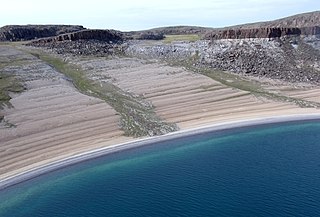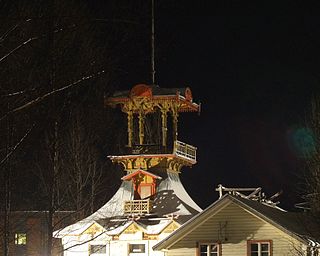| Toppilansaari | |
|---|---|
| District of Oulu | |
 | |
| Country | Finland |
| City | Oulu |
| Areas of Oulu | Tuira area |
| Population (2013) [1] | |
| • Total | 1 673 |
| Postal code | 90510 |
Toppilansaari is a neighbourhood in the Tuira area [2] in the city of Oulu, Finland. It is located on the south side of the Toppilansalmi strait. Toppilansaari was separated from the Hietasaari district while it was rezoned to residential development in the early 2000s. The westernmost part of the neighbourhood was the location for the Finnish Housing Fair in 2005. The Möljä Bridge over the Toppilansalmi strait connects Toppilansaari with the Toppila neighbourhood. The bridge was completed in 2012. [3]

Oulu is a city and municipality of 202,753 inhabitants in the region of North Ostrobothnia, Finland. It is the most populous city in Northern Finland and the fifth most populous city in the country. There are no larger cities in the world, apart from Murmansk Russia, that are more northerly than Oulu. It is also considered one of Europe's "living labs", where residents experiment with new technology at a community-wide scale.

Finland, officially the Republic of Finland is a country in Northern Europe bordering the Baltic Sea, Gulf of Bothnia, and Gulf of Finland, between Norway to the north, Sweden to the northwest, and Russia to the east. Finland is a Nordic country and is situated in the geographical region of Fennoscandia. The capital and largest city is Helsinki. Other major cities are Espoo, Vantaa, Tampere, Oulu and Turku.

Hietasaari is a neighbourhood in the Tuira area in the city of Oulu, Finland. The neighbourhood consists of Mustasaari and Hietasaari islands, separated by the Mustasalmi strait, together with some smaller islands. Hietasaari is zoned as recreation area with only few people living in the neighbourhood permanently.
The Toppilansaari has been an island before, but it has connected into Mustasaari island due to the post-glacial rebound. The Toppila harbour used to occupy both sides of the Toppilansalmi Strait. The harbour has been closed for commercial traffic in 2012, but the activity has ceased since the 1990s. Toppilansaari has also been a historic villa area of which a few villas, like Villa Hannala has survived.

Post-glacial rebound is the rise of land masses after the lifting of the huge weight of ice sheets during the last glacial period, which had caused isostatic depression. Post-glacial rebound and isostatic depression are phases of glacial isostasy, the deformation of the Earth's crust in response to changes in ice mass distribution. The direct raising effects of post-glacial rebound are readily apparent in parts of Northern Eurasia, Northern America, Patagonia, and Antarctica. However, through the processes of ocean siphoning and continental levering, the effects of post-glacial rebound on sea level are felt globally far from the locations of current and former ice sheets.
Port of Oulu is a complex of three separate harbours located at the mouth of Oulujoki river in Oulu, Finland. Port of Oulu is a corporation owned by the City of Oulu. Annual average of 3 million tons of cargo is shipped on 500 vessels. Two of the ports, Nuottasaari and Oritkari, are also rail-served.

Villa Hannala is a historic villa in Toppilansaari, Oulu, Finland. Located at Kahvelitie 1, the villa was built in 1859 for the Snellman family. Decorations and a tower were added in the 1890s. After surviving the threat of demolition, the building became property of the city of Oulu. In 2004–2007 it was renovated by the adult educational centre of Oulu Polytechnic. Today, the villa is almost fully restored. A café was established for visitors.















